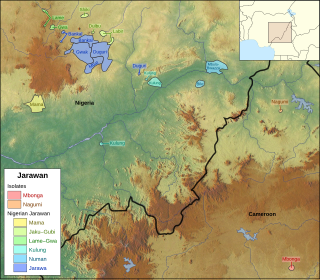Related Research Articles

The Chadic languages form a branch of the Afroasiatic language family. They are spoken in parts of the Sahel. They include 150 languages spoken across northern Nigeria, southern Niger, southern Chad, Central African Republic and northern Cameroon. The most widely spoken Chadic language is Hausa, a lingua franca of much of inland Eastern West Africa.

The Songhay or Songhai languages are a group of closely related languages/dialects centred on the middle stretches of the Niger River in the West African countries of Mali, Niger, Benin, Burkina Faso and Nigeria. In particular, they are spoken in the cities of Timbuktu and Gao. They have been widely used as a lingua franca in that region ever since the era of the Songhai Empire. In Mali, the government has officially adopted the dialect of Gao as the dialect to be used as a medium of primary education.

Benue–Congo is a major subdivision of the Niger–Congo language family which covers most of Sub-Saharan Africa. It consists of two main branches:

Laal is an endangered language isolate spoken by 749 people in three villages in the Moyen-Chari prefecture of Chad on opposite banks of the Chari River, called Gori (lá), Damtar (ɓual), and Mailao. It may be a language isolate and thus would represent an isolated survival of an earlier language group of Central Africa. It is unwritten except in transcription by linguists. According to former Summer Institute of Linguistics-Chad member David Faris, it is in danger of extinction, with most people under 25 shifting to the locally more widespread Bagirmi.
The Adamawa languages are a putative family of 80–90 languages scattered across the Adamawa Plateau in central Africa, in Nigeria, Cameroon, Central African Republic, and Chad, spoken altogether by only one and a half million people. Joseph Greenberg classified them as one branch of the Adamawa–Ubangi family of Niger–Congo languages. They are among the least studied languages in Africa, and include many endangered languages; by far the largest is Mumuye, with 400,000 speakers. A couple of unclassified languages—notably Laal and Jalaa—are found along the fringes of the Adamawa area.

The Maban languages are a small family of languages which have been included in the proposed Nilo-Saharan family. Maban languages are spoken in eastern Chad, the Central African Republic and western Sudan (Darfur).

Jalingo is the capital city of Taraba State in north eastern Nigeria, named in fulfulde (The word jalingo meaning superior place and has been estimated with population of 118,000.
Mwaghavul is an Afro-Asiatic language spoken in Plateau State, Middle Belt Region of Nigeria.

The South Bauchi & East Plateau languages are a branch of West Chadic languages that are spoken in Bauchi State & Plateau State Nigeria.
Mokilko, or Mukulu, is a Chadic language spoken in central Chad. The local name for the language is Gergiko. This is the name used for mother-tongue literacy materials. Mukulu is the name of a village.
The Mumuye–Yendang languages are a proposed group of Savanna languages spoken in eastern Nigeria. They were labeled "G5" in Joseph Greenberg's Adamawa language-family proposal.

The Jukunoid languages are a branch of the Central Nigerian languages spoken by the Jukun and related peoples of Nigeria and Cameroon. They are distributed mostly throughout Taraba State, Nigeria and surrounding regions.
Zing is a Local Government Area in Taraba State, Nigeria. Its headquarters are in the town of Zing.

Jarawan is a dialect cluster that is closely related to, or perhaps a branch of, the Bantu languages. Blench (2011) says that it almost certainly belongs with Guthrie's A.60 languages, which are part of Mbam. They are spoken mostly in Bauchi State, with some also scattered in Taraba State and Adamawa State.
The East Kainji languages are spoken in a compact area of the Jos Plateau in Nigeria, near Jos. There are more than 20 of them, most of which are poorly studied.
Mumuye is by far the most populous of the Adamawa languages. It is spoken in northeastern Nigeria. It is classified in the Leko–Nimbari branch of Savanna languages, as Adamawa is no longer considered a valid family. According to Ethnologue, there are multiple dialects: Zinna, Dong, Yoro, Lankaviri, Gola (Bajama), Gongla, Kasaa, Saawa, Jalingo, Nyaaja, Jeng, Gnoore, Yaa, Sagbee, Shaari, Kugong, Mang, Kwaji, Meeka, Yakoko.
Pangseng is an Adamawa language of Taraba State, Nigeria. It is spoken in Jinlàri (Jimleri), located on the Zing-Lankaviri road.
Rang is an Adamawa language of Taraba State, Nigeria. It is spoken in and around Làmà, and in Zàntó Làmà, Bisagba, Koóyuʔ, and Jauro Nasaraawò.
Ziriya (Jiriya) and Sheni (Shaini) constitute a Kainji language of Nigeria. They are geographically but perhaps not linguistically distinct.

The Ron, Ronic or Ron–Fyer languages, group A.4 of the West Chadic branch of the Afro-Asiatic language family, are spoken in Plateau State, north-central Nigeria.
References
- ↑ Hammarström, Harald; Forkel, Robert; Haspelmath, Martin, eds. (2017). "Mumuyic". Glottolog 3.0 . Jena, Germany: Max Planck Institute for the Science of Human History.
- ↑ Shimizu, Kiyoshi (1979). A Comparative Study of the Mumuye Dialects (Nigeria). Marburger Studien zur Afrika- und Asienkunde. A-14. Berlin: Verlag von Dietrich Reimer. pp. 13–19.
- ↑ Blench, Roger (2019). An Atlas of Nigerian Languages (4th ed.). Cambridge: Kay Williamson Educational Foundation.
- Shimizu, Kiyoshi. 1979. A comparative study of the Mumuye dialects (Nigeria). (Marburger Studien zur Afrika- und Asienkunde A14). Berlin: Dietrich Reimer.
![]() This article incorporates text available under the CC BY 3.0 license.
This article incorporates text available under the CC BY 3.0 license.